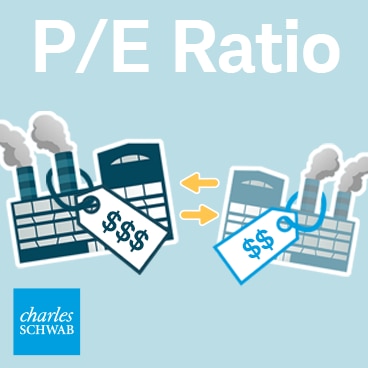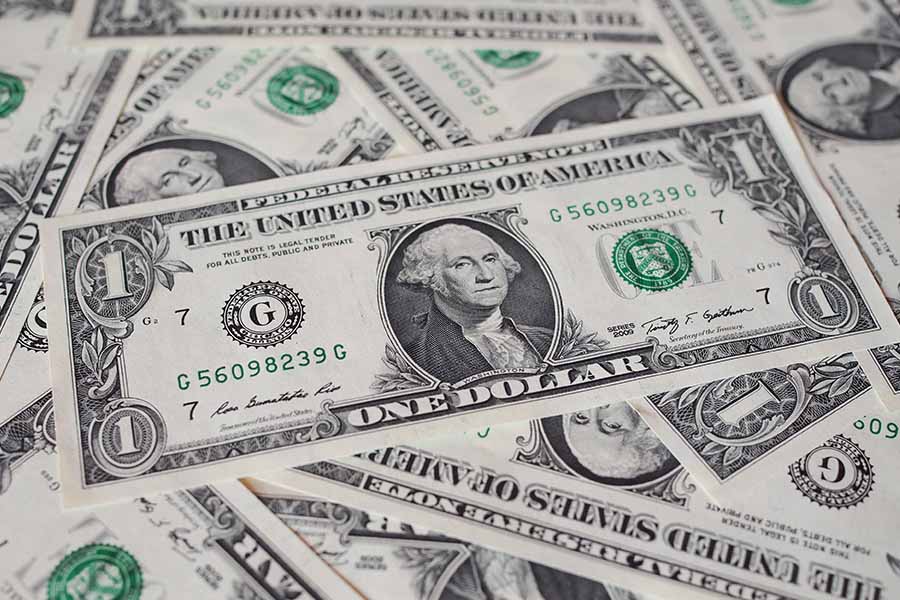
There has been speculation lately that the U.S. dollar is on the verge of a major decline and might even lose its status as the world's major reserve currency. "De-dollarization," or the movement away from using the U.S. dollar as the primary currency of exchange in global trade and investment, has become a hot topic in financial publications. It appears to stem from news that China is beginning to use the yuan in commodity trades with a handful of trading partners, and Brazil and Argentina are exploring the potential for a common currency. Extrapolating these trends, the argument is that demand for dollars will fall, sending its value steeply lower.
Our view is that this argument is overblown. A long-term trend toward diversification of currencies in global financial transactions and trade may develop, but it's a big leap from dollar dominance to de-dollarization.
While the dollar has declined over the past six months, it remains close to a 10-year high versus currencies of countries with which the U.S. trades. It also remains the primary currency used for trade and financial transactions in the global economy. The size of the recent non-dollar transactions that have raised alarm are very small. Trade in yuan accounted for less than 2% of global trade in 2022.
There are few signs that major foreign holders are poised to suddenly shift away from U.S. dollars and there are few other currencies that could take its place as a reserve currency. In our view, a gradual move to a global economy with a less-dominant dollar is possible over time, but we don't see the dollar losing its reserve currency status.
A decade-long bull market
There are several ways to measure changes in the level of the dollar. We generally look at indices that compare the dollar's value to the values of a broad range of currencies, weighted according to the value of their trade with the U.S. By most measures the dollar has fallen by about 8% to 10% in both real and nominal terms since late last year.
As you can see in the chart below, during the past decade, the dollar has been propelled higher by relatively high U.S. interest rates compared to other major countries, strong capital inflows, and its status as a safe haven in times of turmoil. Its value increased by 1.4 times from its 2011 low to its peak in 2022 in real terms (that is, adjusted for inflation).
The dollar's real value has risen during the past 10 years
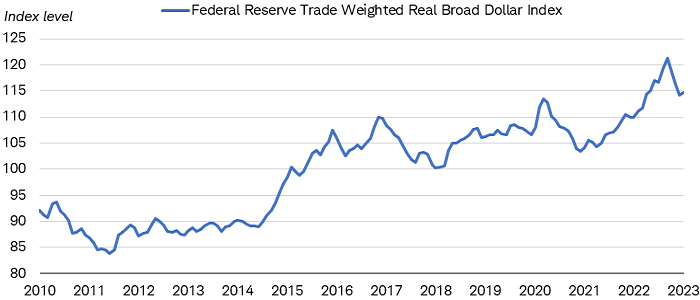
Source: Bloomberg, monthly data as of 2/28/2023.
The U.S. Federal Reserve Trade Weighted Real Broad Dollar Index (USTRBGD Index) is a measure of the inflation-adjusted foreign exchange value of the United States dollar relative to other world currencies.
The dollar's gains have been broad-based, with similar appreciation versus emerging market and major developed market currencies. This chart shows it in nominal terms.
The dollar's gains have been broad-based
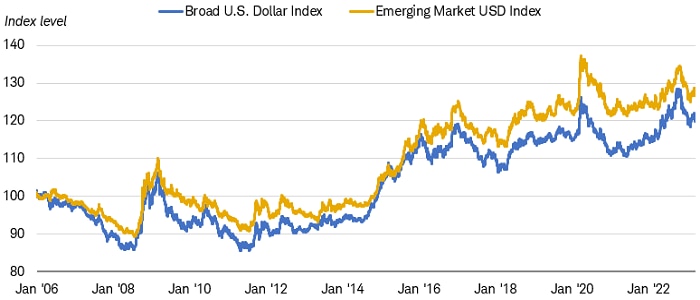
Source: Federal Reserve Bank of St. Louis, daily data as of 3/24/2023.
The Nominal Broad U.S. Dollar Index (Jan 2006=100, Daily, Not Seasonally Adjusted) is a measure of the nominal value of the United States dollar relative to other world currencies. The Nominal Emerging Market Economies U.S. Dollar Index (Jan 2006=100, Daily, Not Seasonally Adjusted) is a weighted average of the nominal foreign exchange value of the U.S. dollar against a subset of the broad index currencies that are emerging-market economies.
Coming out of the long stretch of lackluster growth in the aftermath of the financial crisis of 2008-2009, the dollar was largely range-bound against major currencies, but it began to move higher in 2015 as U.S. interest rates moved up. Higher interest rates boosted returns to dollar-based investors. At that time, central banks in Europe and Japan were keeping policy rates at zero or in negative territory, while U.S. rates were positive. The combination of stronger economic recovery and higher yields helped push the dollar higher.
The dollar has moved higher as U.S. interest rates rose
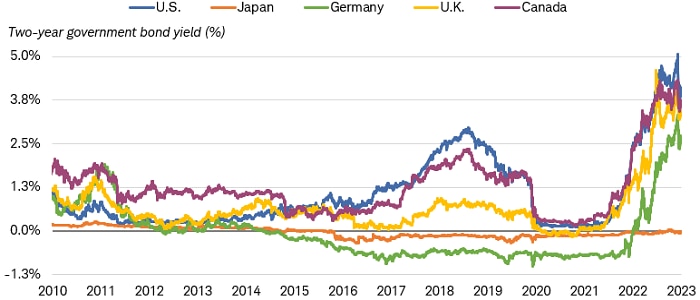
Source: Bloomberg, daily data as of 4/3/2023.
U.S. (USGG2YR Index), Germany (GTDEM2Y Index), Japan (GTJPY2Y Index), U.K. (GTGBP2Y Index), Canada (GTCAD2Y Index). Past performance is no guarantee of future results.
Demand is still strong
Foreign holdings of U.S. Treasury securities have grown since 2013, as you can see in the chart below.
Foreign holdings of U.S. Treasuries have expanded over the past few years
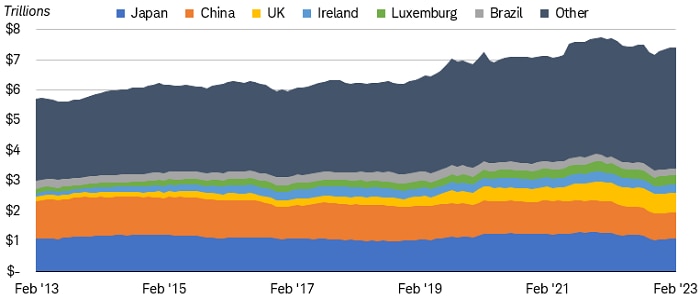
Source: Bloomberg.
U.S. Treasury securities held by foreign holders for China, Japan, UK, Ireland, Luxemburg, Brazil, and Others (HOLDCH Index, HOLDJN Index, HOLDUK Index, HOLDIR Index, HOLDLU Index, HOLDBR Index). Monthly data as of 2/28/2023.
International investment flows indicate that demand for U.S. dollars extends beyond U.S. Treasury securities. With a resilient economy, the U.S. saw the largest inflow of foreign direct investment, long-term investment in businesses and property, of any major economy in 2022. It's also worth noting that much of the rise in investment flows in the U.S. over the past few years has gone into equities.
Foreign holdings of U.S. assets

Source: Bloomberg, monthly data as of 3/31/2023.
Holdings of U.S. Long-Term Securities by Foreign Residents. U.S. Treasuries (USLTTRGR Index), U.S. Agency Bonds (USLTABGR Index), U.S. Corporate and Other Bonds (USLTCBGR Index), U.S. Corporate Stocks (USLTCSGR Index).
Dollar demand for transactional purposes has remained steady over the years, as well. It still accounts for more than 80% of financial market transactions. (Foreign exchange turnover adds up to 200% because there is a currency on each side of the trade.)
Over-the-counter (OTC) foreign exchange turnover by currency
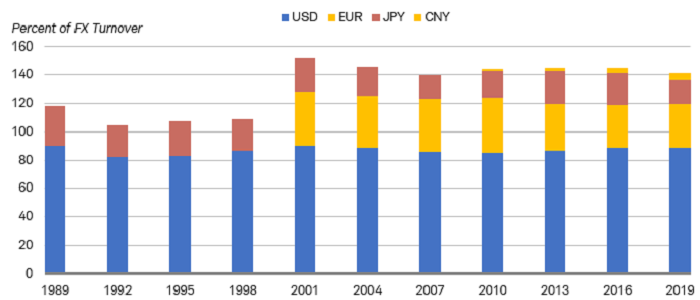
Source: Bank for International Settlements (BIS), triennial data as of 12/31/2022.
The BIS Triennial OTC Derivatives Statistics: FX Turnover by currency. USD = U.S. dollar. EUR = euro. JPY = Japanese yen. CNY = Chinese yuan. For illustrative purposes only.
Dollar's reserve currency status still holding
The dollar's position as the world's major reserve currency is periodically a source of concern among investors, even though its position hasn't changed much in decades. The dollar's share of global reserves has declined gradually over the past 20 years as central banks diversified their holdings, mostly into the euro since its introduction in 1999. Allocations of reserves to other currencies, such as the British pound and Canadian dollar, have gained modestly as well. Overall, however, the dollar still represents about 60% of global reserves, a modest decline from 67% 20 years ago.
Foreign exchange holdings by currency
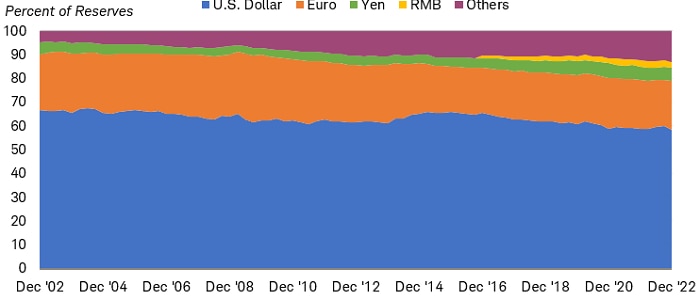
Source: Bloomberg, quarterly data as of 12/30/2022.
Foreign exchange holdings as a percentage of total allocated in U.S. dollars (U.S. Dollar), the euro (Euro), the Japanese yen (Yen), the renminbi/Chinese yuan (RMB), and other reserve currencies, which are the Swiss franc, Canadian dollar, Australian dollar, British pound, and unclassified others (CCFRUSD% Index, CCFREUR% Index, CCFRJPY% Index, CCFRCNYP Index, CCFROTR% Index, CCFRCHF% Index, CCFRCADP Index, CCFRAUDP Index, CCFRGBP% Index).
There aren't currently any viable reserve-currency alternatives
A reserve currency needs to be freely convertible and have deep and liquid bond markets to be considered safe for foreign central banks to hold. Central banks need to know that their money is easily and readily available when needed, particularly in times of stress. The U.S., with a large, open, and liquid market for Treasury securities, fits that role. That's why when the COVID crisis hit the global economy, the U.S. Federal Reserve expanded its swap lines with foreign central banks to enable access to dollars for countries that were struggling to access dollars for trade and debt payments.
While other major countries' markets have these qualities, the size and openness of the U.S. market is difficult to match. Europe's bond markets are more fragmented than the U.S. market although a movement toward euro-denominated sovereign debt issuance would provide a stronger base for it as an attractive alternative. Japan's bond market is closely controlled by its central bank, which owns the bulk of its government debt. China has capital controls, and its currency isn't even freely convertible. Giving up capital controls would mean that the government would relinquish control over investment flows and leave the currency susceptible to decline if domestic investors moved their money elsewhere.
Short- and long-term views
Over the next six to 12 months, we see room for a moderate cyclical decline in the dollar. The main driver is likely to be a greater convergence of interest rates in the major economies as the U.S. Federal Reserve nears the end of its rate hiking cycle while other central banks continue to tighten policy. The European Central Bank and Bank of England appear on track to keep hiking rates due to persistently high inflation. The Bank of Japan may loosen its yield curve control policy, allowing bond yields to move up, which would likely mean less demand for U.S. dollar-denominated assets by Japanese investors. We view these developments as the most significant risk to the dollar's strength in 2023 and 2024.
Longer-term, movement to a multi-currency global economy is possible and could have benefits, particularly for emerging-market countries where moves in the dollar can have big effects on economic growth. However, it would require some major structural changes in many regions—such as reducing barriers to trade and investment, along with strengthening protections for investors. These changes take time and political will.
Diversification benefits
Although we don't see a major bear market in the dollar developing soon, we do believe that investors can benefit over the long run from global diversification. Diversification works best when economic cycles diverge, which may happen later this year if U.S. economic growth slows relative to expansions in other countries. With U.S. interest rates likely to peak in the next few months, returns in global bond markets may improve. The current yield on the Bloomberg Global Aggregate ex-USD index is 2.8%, compared to the Bloomberg US Aggregate Bond Index yield of 4.4%. That yield gap still favors U.S. bond investments, but it is narrow enough to be offset by a modest drop in the dollar.
Overall, a further easing in the dollar's strength over the course of 2023 could be an opportunity for investors to diversify globally, but we don't see it portending a major structural change in the world currency order.
The information provided here is for general informational purposes only and should not be considered an individualized recommendation or personalized investment advice. The investment strategies mentioned here may not be suitable for everyone. Each investor needs to review an investment strategy for his or her own particular situation before making any investment decision.
All expressions of opinion are subject to change without notice in reaction to shifting market conditions. Data contained herein from third-party providers is obtained from what are considered reliable sources. However, its accuracy, completeness or reliability cannot be guaranteed. Supporting documentation for any claims or statistical information is available upon request.
Examples provided are for illustrative purposes only and not intended to be reflective of results you can expect to achieve.
Investing involves risk including loss of principal.
Past performance is no guarantee of future results and the opinions presented cannot be viewed as an indicator of future performance.
Indexes are unmanaged, do not incur management fees, costs and expenses and cannot be invested in directly. For more information on indexes please see schwab.com/indexdefinitions.
Fixed income securities are subject to increased loss of principal during periods of rising interest rates. Fixed-income investments are subject to various other risks including changes in credit quality, market valuations, liquidity, prepayments, early redemption, corporate events, tax ramifications and other factors. Lower-rated securities are subject to greater credit risk, default risk, and liquidity risk.
International investments involve additional risks, which include differences in financial accounting standards, currency fluctuations, geopolitical risk, foreign taxes and regulations, and the potential for illiquid markets. Investing in emerging markets may accentuate these risks.
Diversification and asset allocation strategies do not ensure a profit and do not protect against losses in declining markets.
This information does not constitute and is not intended to be a substitute for specific individualized tax, legal, or investment planning advice. Where specific advice is necessary or appropriate, Schwab recommends consultation with a qualified tax advisor, CPA, financial planner, or investment manager.
Currencies are speculative, very volatile and are not suitable for all investors.
The Schwab Center for Financial Research is a division of Charles Schwab & Co., Inc.
Source: Bloomberg Index Services Limited. BLOOMBERG® is a trademark and service mark of Bloomberg Finance L.P. and its affiliates (collectively "Bloomberg"). Bloomberg or Bloomberg's licensors own all proprietary rights in the Bloomberg Indices. Neither Bloomberg nor Bloomberg's licensors approves or endorses this material, or guarantees the accuracy or completeness of any information herein, or makes any warranty, express or implied, as to the results to be obtained therefrom and, to the maximum extent allowed by law, neither shall have any liability or responsibility for injury or damages arising in connection therewith.
0423-328E